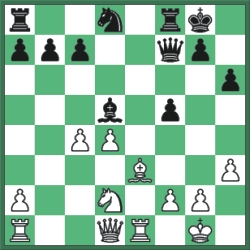|
Time Out
The initiative Chess
The advantage of making the first move is quite evident, as it allows you to determine the type of game that you are going to play. That gives you what chess players relish so much--the initiative. It is not enough to win a game, but an initiative can be transformed into a more tangible form of advantage with accurate play. In fact, a lasting initiative can put so much pressure on the opponent that he may lose patience and make elementary mistakes.
The first move, however, has various meanings, depending on the level of the play. Among beginners, it may well be wasted , as the first player may not know how to manoeuvre to keep the initiative alive. At the masters level, it is a different story--White may succeed in having an edge for a long time. But he will still have to work hard for the full point!
In the early days of modern chess, players were convinced that it was White's birthright to attack vigorously. In most cases, Black was the punching bag. And it was also more or less obligatory for the second player to accept the brilliant sacrifices, that often led to a forced mate. It was only with the emergence of Wilhem Steinitz that players began to realise that there was no need for the player under attack to be that obliging! Many new ways of refuting an attack or maintaining balance were found. The brilliant gambits of the Romantic era were slowly replaced by sound opening variations. Players were defending a lot better.
That said, modern players are playing chess a good deal more tactically than their predecessors did, say 40 or 50 years back. Chess is now a game of true professionals . So they cannot perhaps afford to have too many lifeless draws. But few modern players are relying on gambits. They usually aim to reach a sharp position after the opening and then go for tactical complications. Well, positional masters have not lost any ground-- what we notice is that chess is getting more and more dynamic.
Today, watch how a genuine romantic outplays a devout hypermodern.
White-Frank James Marshall
Black-Richard Reti [C49]
Vienna 1908
1.e4 e5 2.Nf3 Nc6 3.Nc3 Nf6 4.Bb5 Bb4 5.00 00 6.d3 Bxc3 7.bxc3 d6 8.Bg5 Qe7 9.h3 Nd8 10.Bc4 Be6 11.Nd2 h6 12.Be3 d5 13.exd5 Nxd5 14.Bxd5 Bxd5 15.d4 exd4 16.cxd4 f5 17.Re1 Qf7 18.c4 Bxc4 19.Nxc4 Qxc4 20.d5 Rf7 21.Rc1 Qb5 22.Bf4 c6 23.d6 c5 24.Qd5 Rc8 25.Re7 Qc6 26.d7 Ra8 27.Re8+ Kh7 28.Qxc6 bxc6 29.Rd1 a6 30.Bc7 Ra7 31.Rxd8 1-0.

Position after 18.C4!
-PATZER
Copyright (R) thedailystar.net 2006
|
